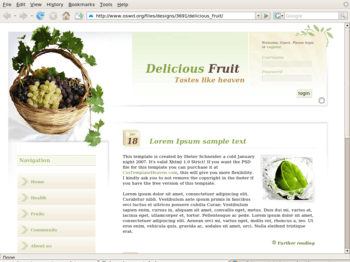Web Design/An introduction to Project Management
< Web Design|
Web Design → An introduction to Project Management
|
Here's an activity that will help you demonstrate your ability to create task-breakdowns and Gantt charts, as well as reflect on some of the underlying principles of Project Management.
Scenarios
Pick a scenario from the following, or create your own!
Scenario 1: Party socialite
You're known around the joint as a bit of a party goer... people constantly come up to you asking when your next party is going to happen. You've already put on 4 big nights this year, but organising the whole deal is not something that you like doing. So, to make things easier for next time, you decide to plan this one in a way that you can re-use...
Variations: Organising an day-trip, dinner party, pub-crawl etc, community event.
Scenario 2: A holiday with friends
Getting away with friends has always been important to you, but for some reason, your friends always leave it up to you to organise the whole trip! Every time that you go away, you always pack similar stuff, but up until now, you've never kept the list of things that you have to pack or get done before going away. Now's the time...
Variations:
Scenario 3: Choose your own adventure
And add it back in here so that other people can use your idea! You could even use a real project that you're working on!
Your task
With your chosen scenario, you'll be specifying and ordering your tasks, as well as setting their durations to produce a beautiful Gantt chart. As well as this, we'll research and reflect a bit on what we're actually doing with Project Management. You can choose whether you demonstrate your work by uploading it to your blog (including a screenshot of your Gantt chart), or as a printed document. Here we go:
Create a task-breakdown for your project
Use your scenario to create a task-breakdown for your project. You should aim to have around 15-20 tasks (don't make it too big!) that need completing for your project. A simple list will do fine, such as:
- Find out who's interested
- Ring Adam to see if he can round up the gang
- etc.
- Find accomodation
- ...
Estimate your task times
Once you're happy with your task-breakdown, using the project management tool of your choice (one that can be used to produce Gantt charts, MS Project and Primavera can be the best choices), have a go at estimating how long it will take to complete each task.
Produce your Gantt chart
Now you're ready to specify what comes before what! Use your tool to specify the predecessors for each task (what has to happen before a task can start). This should get you your Gannt chart!
When you're happy with your Gantt chart, you might want to do a screenshot so you can upload the image to your blog.
Research and Reflection
If you're planning on using your blog to demonstrate your work, now's a good time to create a new post introducing your scenario, add your task-breakdown and include the image of your Gannt chart.
Using your research skills, include a reflection on the following:
- Outline the stages of a typical project management lifecycle. Describe how the some of the stages match your own project plan as well as where your own project plan differs. Make sure you include references/links to any resources you use!
- List the variables that Project management tries to control. Describe three different scenarios that demonstrate how each of these variables will be affected if something unexpected occurs with your own plan (eg. a plane is delayed, less people turn up than expected, the food at your resort is a lot more expensive than expected).Again, make sure you include references/links to any resources you use!
HTML: What is HTML, Advanced HTML Tutorial, HTML Challenges, Lists and Tables, The Structure of HTML, Pen and Paper HTML activities
CSS: Learning Basic HTML and CSS, CSS challenges, Embedded CSS, Basic HTML and CSS Tutorial, Inline CSS, Develop cascading style sheets, CSS3 Animations
PHP: Simple functions in PHP, Dynamic websites, PHP challenges, Dynamic websites with PHP, Generating a receipt with PHP, Responding to HTML forms with PHP,
JavaScript: An Introduction to Programming with JavaScript, JavaScript Challenges, Getting to know JavaScript events, Getting to know the Document Object Model with JavaScript, JavaScript pen-n-paper activities, Web Programming Intro, Produce basic client side script for dynamic web pages
XML: XML challenges
Databases: Creating Database Tables
Projects: A small website project, A step-by-step web design project, Build a basic web page, Build a small website
Challenges: Web design, HTML, AJAX, CSS, JavaScript, PHP, XML, Information Architecture, Algorithms
Activities: Web design group learning activities, Pen and Paper HTML activities, A Web Design Quiz show, Ordering Tasks for a Web Project, Paired Bio Pages, Scoping a Small Project, Emerging Technologies Research Activities
Project management: An introduction to Project Management, Developing a Client Project
Design: Accessibility, Design Principles for Web Design, Design Suggestions
Testing: Testing Website performance, Website Performance Test Plan
Publishing: Getting Your Site On the Web
Certification and standards: Cert IV Website Qualifications in Australia, Australian Qualifications, Web design qualifications
Professional development: Contribute to personal skill development and learning, Useful Applications, Useful Books, Emerging Technologies, Using the Internet as a Learning Tool
Course meta-information: Web Design, About the web design learning project, New Structure, Sample Timetable

